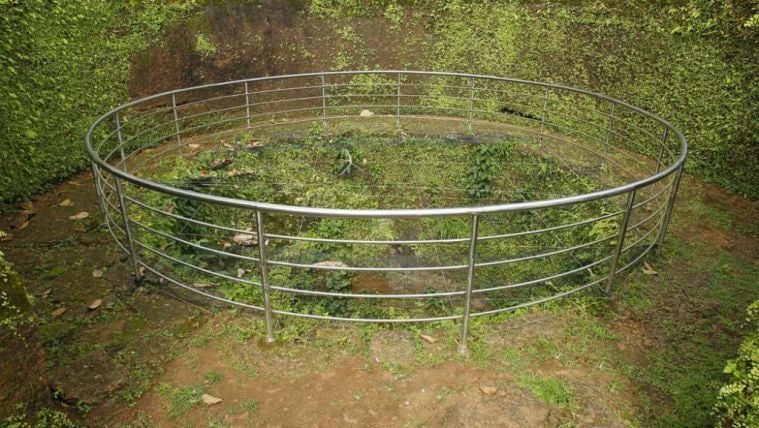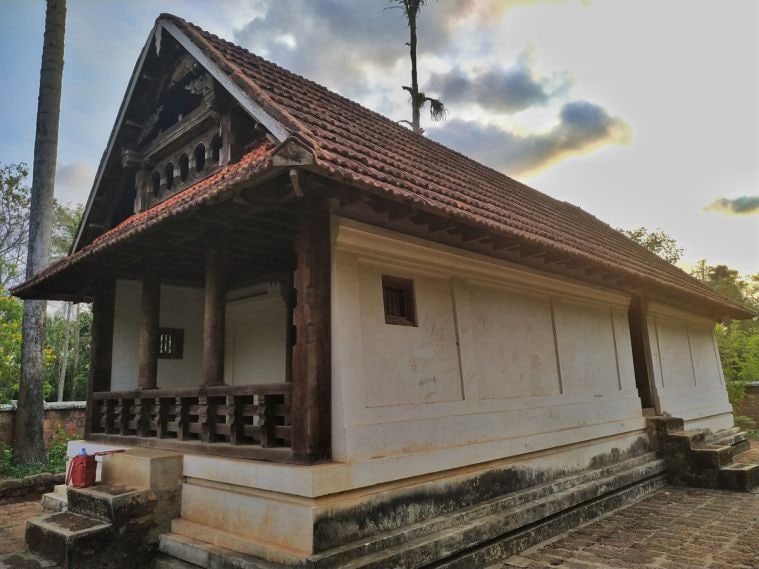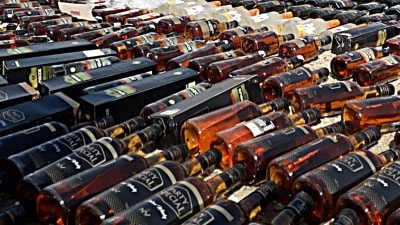From Mamangam to Mahatma Gandhi: Why there is a call to protect relics in Kerala’s Thirunavaya
This village in Malappuram district used to witness one of the most important trade festivals in medieval India. Also, the suicide squads' mission to assassinate the Zamorin and the bloodbaths associated with it.
 Mamankam, a grand assembly of rulers, was held once in 12 years in Thirunavaya. The Zamorin, the ruler of Kozhikode, would stand on a platform called the 'nilapadu thara' (pictured) cocooned by his soldiers (Source: malappuram.nic.in).
Mamankam, a grand assembly of rulers, was held once in 12 years in Thirunavaya. The Zamorin, the ruler of Kozhikode, would stand on a platform called the 'nilapadu thara' (pictured) cocooned by his soldiers (Source: malappuram.nic.in).In 1984, K J Yesudas’s Tharangini Records came up with an album Vasantha Geethangal. It had 10 songs but none became as popular as ‘Mamangam pala kuri kondadi‘, sung by Yesudas himself. Not discounting the grandeur of Raveendran Master’s music but the biggest allure of the song was the lyrics by Bichu Thirumala, who opened a window to Kerala’s history from medieval times, and to the bloodshed and tales of valour on the banks of Bharathappuzha in Thirunavaya all those centuries ago.
Why exactly are we talking about the song now? Recently, a few history researchers urged the Kerala government to declare Thirunavaya, in the present-day Malappuram district, a heritage village and protect the historical relics in the area.
So what makes Thirunavaya special in Kerala’s history?
Mamangam: A trade fair that turned into a battlefield
Mamangam was a 28-day-long trade festival celebrated once every 12 years on the banks of the Bharathappuzha, also known as Nila. Traders from various parts of India and as well as places such as China, Ceylon, Arabia and Europe used to arrive by ship at the Ponnani port and then move to Thirunavaya to participate in the trade fair held on the premises of the Navamukunda temple, believed to be around 5,000 years old now.
Famous historian MGS Narayanan, in his book Keralacharithrathile 10 Kallakathakal, compares
Mamangam to many such trade fairs held on riverbanks in Prayag, Haridwar, Ujjain, Gokarna and Kumbhakonam in medieval India.
There is no consensus on when the first Mamangam was held, but it is believed that the Chera kings began the duodecennial trade festival. The last Chera ruler passed on the right to conduct it to Valluvakonathiri (rulers of the Valluvanad region) around the 12th century.
 The Navamukunda temple is believed to be around 5,000 years old now. (Source: Wikimedia Commons)
The Navamukunda temple is believed to be around 5,000 years old now. (Source: Wikimedia Commons)
Enter Zamorin and chavers
The Zamorins, the rulers of Kozhikode, in a bid to expand their kingdom, beat the Valluvakonathiri in the 14th century and secured the right to preside over Mamangam after capturing several Valluvanadan provinces, including Thirunavaya.
The Valluvakonathiris decided to avenge the defeat as well as the murders of their princes by sending suicide squads called chavers to fight the Zamorin’s army during Mamangam. At each Mamangam, the Valluvakonathiri’s chavers would come with an intention to kill the Zamorin. The chavers, belonging to prominent Nair families like Putumanna Panikkars, Kokat Panikkars, Chandrath Panikkars and Verkot Panikkars, began their journey to Thirunavaya from the chaver thara at the Thirumandhamkunnu temple in Angadipuram.
At Mamangam, the Zamorin would stand on a platform called the ‘nilapadu thara’ cocooned by his soldiers. The Zamorin army comprised around 40,000 men, according to MGS Narayanan. Bodies of the chavers who died during the fight were thrown into a nearby well called the ‘manikinar’. Some records say the injured warriors were trampled down by elephants.
 Bodies of the chavers who died during the fight were thrown into a nearby well called the ‘manikinar’. (Source: malappuram.nic.in)
Bodies of the chavers who died during the fight were thrown into a nearby well called the ‘manikinar’. (Source: malappuram.nic.in)
William Logan, a Scottish officer of the Madras Civil Service under the British Government, in his book Malabar Manual (1887) described a Mamangam from 1683 based on archival materials he found during his time in India: “Amid much din and firing of guns the Morituri, the Chaver Nairs, the elect of four Nair houses in Waluvanad, step forth from the crowd and receive the last blessings and farewells of their friends and relatives. They have just partaken of the last meal they are to eat on earth at the house of the temple representative of their chieftain; they are decked with garlands and smeared with ashes. On this particular occasion, it is one of the houses of Putumanna Panikkar who heads the fray. He is joined by seventeen of his friends – for all who so wish may fall in with sword and target in support of the men who have elected to die.”
For nearly four hundred years, the chavers, coming to Thirunavaya over this blood feud, never managed to kill any of the Zamorins of the times, though one of them came close to it. In 1695, a 16-year-old boy named Chandrathil Chanthunni reached the ‘nilapadu thara’ and the Zamorin had a narrow escape, according to Velayudhan Panikkasseri’s Sancharikal Kanda Keralam (2001).
The last Mamangam was said to be held in 1755 before Mysore’s Hyder Ali invaded Malabar and ended the Zamorin’s prominence.
 Mamangam was a 28-day-long trade festival celebrated once every 12 years on the banks of the Bharathappuzha, also known as Nila. (Source: Wikimedia Commons)
Mamangam was a 28-day-long trade festival celebrated once every 12 years on the banks of the Bharathappuzha, also known as Nila. (Source: Wikimedia Commons)
Remains of Mamangam
Today, Mamangam relics such as the ‘nilapadu thara’ and the ‘manikinar’ are protected by the Kerala government’s archaeology department. Pazhukka mandapam, from where the Zamorin family members used to watch the festivities; marunnara, where the Zamorin kept the gunpowder; and the Changampally Kalari, where the soldiers used to train, have all been maintained under the Nila project from 2010.
 The Changampally Kalari, where the soldiers used to train. (Source: Wikimedia Commons)
The Changampally Kalari, where the soldiers used to train. (Source: Wikimedia Commons)
In memory of Mahatma Gandhi
While the remains of Mamangam are in relatively better shape, the Cheerpumkundu iron bridge, which was used for the immersion of Mahatma Gandhi’s ashes on February 12, 1948, is in ruins these days. Known as Kerala Gandhi, freedom fighter K Kelappan in 1949 launched the week-long Sarvodaya Mela in Thirunavaya in memory of the Father of the Nation.
Navamukunda temple
The Navamukunda temple is one of the 108 major Vishnu temples in India. It is famous for its sculptures, including the 10 incarnations of Vishnu. Renowned craftsman Perumthachan is believed to have renovated the temple more than 1,000 years ago. Devotees come to the temple to perform rituals for their ancestors on the banks of the river.
Mamangam in movies
Besides the song mentioned at the beginning, Mamangam has featured in popular culture through two Malayalam movies of the same name: one in 1979, directed by Navodaya Appachan and starring Prem Nazir, and the other in 2019, directed by M Padmakumar with Mammootty in the lead role.
- 01
- 02
- 03
- 04
- 05






































